
twombly : surf riding in hawaii, 1899
| home | catalogue | history | references | appendix |
 |
surfresearch.com.au
twombly : surf riding in hawaii, 1899 |
Internet Archive
http://archive.org/details/hawaiiitspeoplel00twom
In Part 1, Ancient
Hawaii and Folklore, reproduces the story of "Kelea the Surf Rider"
as Chapter V and some of the other ancient legends have surfing references.
These are not reproduced
here.
Twombly also published
Kelea:
The Surf-rider, a Romance of Pagan Hawaii.
Fords, Howard, and
Hulbert, New York, 1900.
See
Internet Archive
http://archive.org/details/adh9887.0001.001.umich.edu
2. The Photographs
While unaccredited,
a large portion of the numerous photographs are the work of James J. Williams.
He began the monthly
tourist magazine Paradise of the Pacific in 1888, and served
as business manager with editor Frank Godfrey until 1893.
It was founded
with a royal charter from King Kalakaua, who was one of Williams' photographic
subjects.
- James J. Williams
http://en.wikipedia.org/wiki/User:W_Nowicki/James_J._Williams
i. Surf Board
Rider, page 40.
The Hawaiian Historical
Society cites this photograph as:
- James J. Williams,
Male surfrider with board, (6051)
Hawaiian Historical
Society Historical Photograph Collection (accessed January 29, 2013)
http://www.huapala.net/items/show/6798
The identifier number
is 6051, and the catalogue notes "Same as Davey photo 3343," discussed
below at (iii).
Unfortunately, the
image is not dated.
The collection is
described as:
"Photographs from
a collection of albumin prints by James J. Williams (18531926) acquired
by the Hawaiian Historical Society in May 2002. Williams was active as
a photographer in Hawai'i from 1879 to 1926.
He was one of many
photographers who opened a studio or gallery in Honolulu.
By 1890, approximately
sixty photographers worked in the Islands, twenty in Honolulu."
- Hawaiian Historical
Society Historical Photograph Collection (accessed January 29, 2013)
http://www.huapala.net/collections/show/3
The image has been
extensively reprinted, notably as the cover image for Tim DeLaVega's Surfing
in Hawaii: 1788-1930 (2011).
He notes, without
identifing the photographer, in the frontpiece:
"ON THE COVER: A
surfer in a malo (loincloth) poses with his surfboard around 1893.
This iconic photograph
was one of the most popular images published around the end of the 19th
century.
The surfer may be
Charles Kauha, who also posed for the Frank Davey photograph on page 32.
Waikiki at this
time was a sleepy bay unprepared for the coming century of change.
(Courtesy DelaVega
family archives.)"
Presumably, the date
of "around 1893" is based on the publication of the image in Paradise
of the Pacific around this time and during the period when Williams
was the magazine's business manager.
Tim DeLa Vega subsequently
posted the following update online:
"This photo was taken
by by James J. Williams, the famous Honolulu photographer who did many
of the early surfing images, friend of King Kalakaua, Robert Lewis Stevenson
and established "Paradise of the Pacific" magazine, 1888, presently Honolulu
Magazine.
Discovery thanks
to Spencer Croul."
- The Surfing
Heritage Foundation (viewed 30 January 2013)
http://www.surfingheritage.org/2010/05/ben-aipas-great-grandfather.html
In both images (Williams,
1893 and Davey, 1889) the location, surfboard, and pose are similar, but
not identical.
Both surfers are
dressed in a traditional malo, which was probably no longer in general
use by this time.
It was probably
added as a prop to enhance the "traditional native" element, deemed to
be attractive to visiting tourists.
Twelve months after publication in Twomby (1899), the photograph was reprinted in John L. Stevens and W. B. Oleson's Riches and Marvels of Hawaii in 1900, the title page noting the book is "Profusely Enriched with Rare and Beautiful Photographs by Miss Nellie M. Stevens."
2. Diamond Head,
page 40.
Whereas DeLaVega
notes that "Davey photographed Charles Kauha in 1898 in numerous poses,
but none are of Kauha surfing," this may not be the case for Williams'
Surf
Rider with Board (1893).
It is possible that
he is the same the surfer riding prone in the photograph titled Diamond
Head, where the the camera's perspective is identical. The images were
possibly shot on the same day, although there is considerable more swell
evident in Diamond Head.
See aligned images,
below.
The apparent length
of the board may be exaggerated by the rider laying at the tail, his legs
trailing in the wave.
3. "Same as Davey
photo 3343"
The image specified
is not easily locatable in the HHSHPC website.
It probably refers
to:
Frank Davey, "Native
with Surf Board, Honolulu, H.I.",
Hawaiian Historical
Society Historical Photograph Collection (accessed January 29, 2013)
http://www.huapala.net/items/show/73
Titled "Native with
Surf Board, Honolulu, H.I.," it is described and dated as "An unidentified
Hawaiian surfer poses for photographer Frank Davey in Waikiki circa 1899."
There is no identifier
number.
As previous noted,
although there are strong similarities, it is not the same image as Williams'
Surf
Rider with Board (1893).
The photograph was
printed as the frontpiece of Charles Warren Stoddard's A
Trip to Hawaii (1901) and later reproduced in Tim DeLaVega's Surfing
in Hawaii (2011) on page 32.
The caption reads:
"CHARLES KAURA AND
HIS &ALlA SURFBOARD, APRIL 1898.
London-born Frank
Davey photographed Charles Kauha in 1898 in numerous poses, but none are
of Kauha surfing.
Davey was very prolific,
although Davey only documented Hawai'i from 1897 to 1901.
The one on this
book's cover is found on an Island Curio Store undivided-back postcard
made between 1901 and 1907.
During this time,
the undivided back was for the address only, allowing no place on the card
card for a message.
People of course
started writing messages all over the postcards, which caused the government
in 1907 to establish divided-back postcards so senders could write the
back next to the address.
(Above, courtesy
Hawai'ian State Archives; below Dan Pincetitch.)"
Charles Kaura
and his Alia appears as stock number 9 in Frank Davey's personal photograph
album, titled as Native with Surfboard, Honolulu, H.I.
In addition, number
12 shows two natives and a beached outrigger canoe at Waikiki with a pier
and bath-house in the backgound, titled Surf Boat of the Native, Honolulu,
H.I.
Unusually, the perspective
is away from Diamond Head and one canoe surfer, to the left, bears some
resemblance to Charles Kaura.
Number 248 illustrates
two natives surfriding in an outrigger canoe with Diamond head in the background,
titled Surf Riding, Waikiki, Honolulu, H.I.
The outrigger canoe
and its riders appear to be the same as shown in number 12.
This later is probbaly one of two postal cards exhibited by Davey in Paris in 1900, where he received awards for "artistically colored pictures of surf riding and the lei women."
- The Hawaiian Gazette, Honolulu, October 12, 1900, page 4.
Davey's personal
collection is bound in leather and bears a hand written title and date,
The
Hawaiian Islands, April 1898.
Most illustrations
have printed stock number, title, and accreditation to Davey Photo Co.
H.I.
Some titles are
written by hand, and some are signed F. Davey, H.I. in pencil.
The vendor, on careful
examination, concluded the the images are hand tinted water colours, processed
from photographs.
It is suggested
that the photographs were "transfered to art paper, lightened to a point
where they were no longer photos," and then hand painted with water colours
using "the faint outline" as a guide.
However, "faint
outlines can not be seen."
See:
http://www.ebay.com.au/itm/RARE-FRANK-DAVEY-PERSONAL-PHOTO-ART-ALBUM-1898-HAWAII-/200672762239
Frank Davey
Frank Davey (1860
- ) began his career as an illustrator and photographer in London, following
"the able instruction of his father, William Turner Davey, a member of
the Royal Academy and one of the best known historical engravers of London."
After working for
Henry Van Der Weyde, he left England in 1880 and worked for M. Walery in
Paris and Napoleon Sarony in New York, before taking a position at
I. W.Taber's studio in San Francisco, circa 1886.
In 1896 Davey toured
the Orient, including Japan and China, before arriving in Honolulu
on the Australia on the 5th January 1897.
- The Hawaiian
Gazette Honolulu, September 20, 1904, page 2.
- The Hawaiian
Star, January 5, 1897, page 8.
His journey across
the Pacific was possibly inspired by Taber's six-week photographic trip
to the Hawaiian Islands in 1880, where he photographed, among other subjects,
the Hawaiian King Kalakaua, completing a commission of three full-length
portraits.
Taber's San Francisco
studio, gallery, and negative collection were destroyed in the 1906 San
Francisco earthquake, ending his photographic career.
- wikipedia.org:
I. W. Taber (viewed 1 February 2013)
http://en.wikipedia.org/wiki/I._W._Taber
Davey opened a richly
furnished studio, with an "electric elevator" to the upper floors, in theMott-Smith
building, near Fort Street, in Honolu on 31st August 1897.
The first floor
reception room contained albums of Island views and some sample portraits
by Mr. Davey, including Lady Randolph Churchill, Stanley, and Gen. Lew
Wallace.
The press reported
that Davey, besides being a photographer, was "a cartoonist of note in
London, and his scrap-book contains many interesting newspaper reproductions
of his pencil work."
In addition, he
was experienced in "bas-relief, mezzotint and iridium effects, which are
superior to any others made."
- The Hawaiian Gazette, Honolulu, August 31, 1897, page 5.
In January 1904, Davey was still a resident of Honolulu, listed as a juror for the Hilo term of Federal Court, and in February, after going into receivership, all the negatives, prints, material, photo graphic stock, good will, and the lease of the Davey Company were purchased by the rival studio of Rice & Perkins.
- Hilo Tribune,
Hawaii, January 1, 1904, page 3.
- The Hawaiian
Star, Honolulu, February 9, 1904, page 8.
That year, Rice and
Perkins supplied several surf riding photographs for Emma Nakuina's Hawaii,
Its People and Their Legends (1904).
See:
1904 Rice and
Perkins : Surf Boating
and Riding at Waikiki.
By late 1904, Davey had left Honolulu and relocated to San Jose, California, where he formed at partnership with Andrew P. Hill.
- The Hawaiian
Gazette Honolulu, September 20, 1904, page 2.
The author has
endeavored to present in this volume a readable and reliable History of
Hawaii for young readers, which he hopes
will also be
interesting to older people.
He has used material
from the best authorities, including Fornander, Alexander, Ellis, Jarves,
and Dibble, also personal information from Hawaiian and other sources.
" The Legends
and Myths of Hawaii," collected by the late King Kalakaua, furnished an
attractive style for some of the " Folklore " incorporated in this book.
He also acknowledges
his obligation to Hon. Gorham D. Oilman of Newton, Massachusetts, for the
use of his Hawaiian library, the largest private collection of Hawaiian
books and pamphlets in this country.
Page 34
To offset these
terrors for the dead and the living, there were, of course, some better
things in life.
There were games,
especially when a temple was dedicated or a victory gained.
The men had wrestling
matches and contests with spears or with rude sleds, on which they slid
down the steep hills.
Men and women
contended in surf riding, either in canoes or on surf boards.
This was a pastime
in which the Hawaiians excelled.
The swimmers took
a board of light wood, about eight feet long and eighteen inches wide,
stained black and highly polished.
With this, they
swam out to sea, diving under the rollers until they reached the outer
Page 35
line of breakers.
Then, lying flat
on the board, they balanced themselves upon the forward slope of the highest
breaker and rode with the speed of a race horse to the shore.
Sometimes they
stood up on the board and balanced themselves with great skill, using a
paddle or a pole.
The women, even
some from the chiefs' families, were often as expert in this sport as the
men.
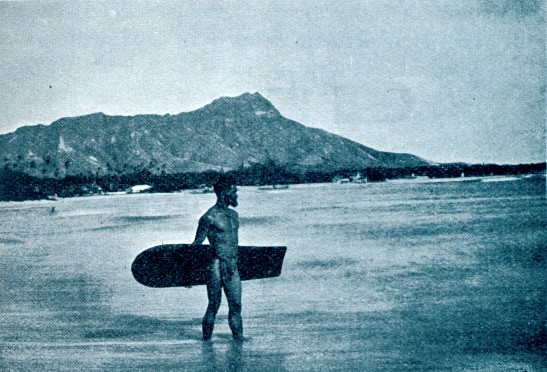
SURF BOARD RIDER.
Page 40
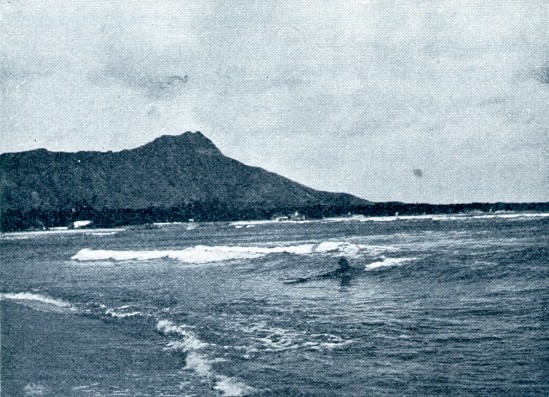
DIAMOND HEAD.
Prone surf rider
in the shore break, note the length of the board.
This almost certainly
the same surfer and board in the photograph on page 35, where the the camera's
perspective is identical.
Page 102
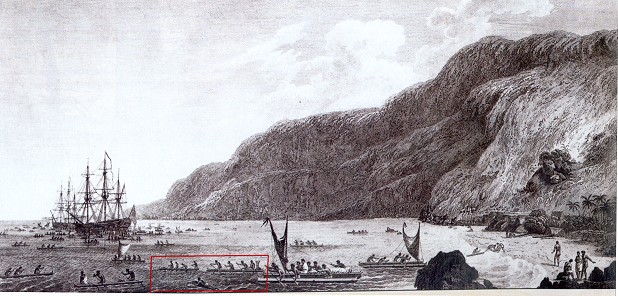
THE ARRIVAL OF
CAPTAIN COOK. (cropped, surfboard paddler highlighted)
[John Webber (Artist)
Engaving by W. Byrne : "A View of KaraKakooa, in Owyhee."]
Page 151
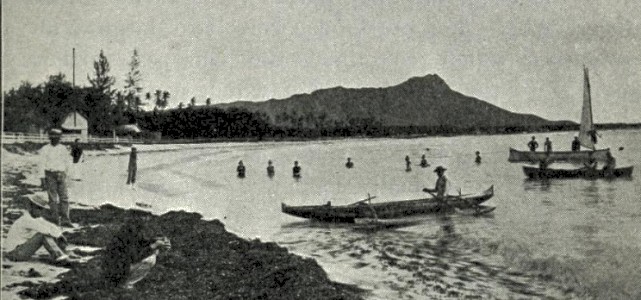
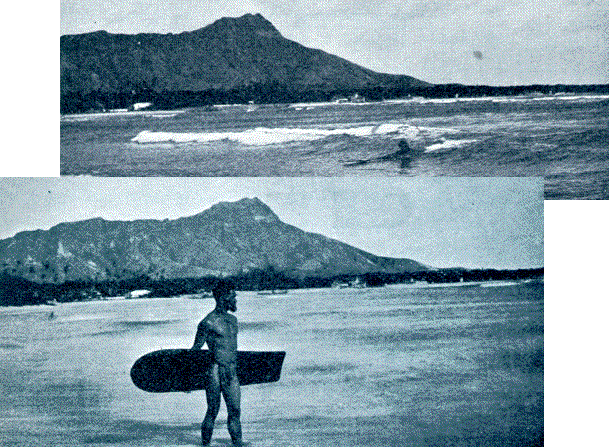
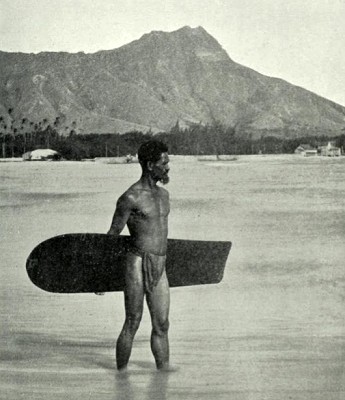
SURF BOARD RIDER.
Printed in Twombly:
Hawaii and Its People (1899)
Cropped from
Stevens and Oleson: Riches and Marvels of Hawaii (1900)

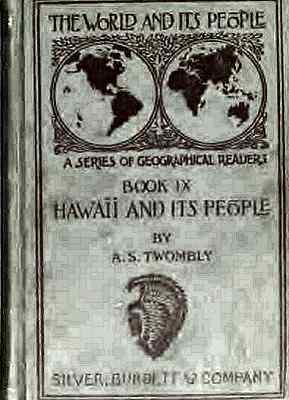 |
Hawaii and Its People - The Land of Rainbow and Palm. World and Its People: A Series of Geographical Readers, Book IX. Silver, Burdett & Co., 1899, New York, 1899. |

| home | catalogue | history | references | appendix |